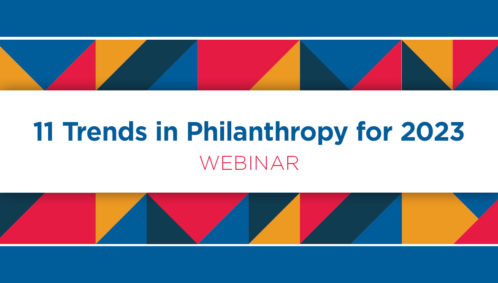11 Trends in Philanthropy for 2023


 The philanthropic sector is an ecosystem: a web of interdependent actors, infinitely variable, striving constantly to build something greater than the sum of its parts.
The philanthropic sector is an ecosystem: a web of interdependent actors, infinitely variable, striving constantly to build something greater than the sum of its parts.
In biology, ecosystems are made up of organisms — living things that are themselves made up of individual cells and multi-part systems working together as a single whole. Each organism is unique, responding differently to fluctuations in its environment.
The same is true in philanthropy. Each nonprofit, foundation, donor, community, or network is affected differently by our national and global zeitgeist. But as each player adapts to changes in that context, the sum of those many reactions can become a force of its own.
That’s why the word “organism” — and its forms, “organization” and “organize” — seems to be at the heart of this, our seventh annual 11 Trends in Philanthropy publication. The issues we cover this year zoom in on how the forces rippling across our ecosystem are playing out at the level of individual organizations. Public accountability, investment decisions, distributed leadership — these are questions that each person and each partnership must answer for itself.
Philanthropy is also getting organized and reorganized. Funding collaboratives, unionized labor, new governance structures — individual actors are making moves, coming together to cause change on a broader scale. As ideas and methods gain attention, they introduce yet more dynamism to the environment.
Today, we see this push-pull at work. In 2023 and beyond, we’ll see how it plays out.

Recent research from the Bridgespan Group illustrates an undeniable rise in funder collaboratives in the sector — especially since the beginning of the pandemic. Many of the biggest names in philanthropy, such as the Bill & Melinda Gates Foundation and MacKenzie Scott, are already onboard. Together, they’re repositioning collaboration as the starting point for change — and moving hundreds of millions of dollars.

Ever since Lester Salamon rang the first alarm bell about organizational infrastructure challenges in 1999, the sector has tried to come to terms with what ”capacity building” is and how best to do it. Philosophies and tactics run the gamut, from one-off training exercises to general operating support. As more nonprofits and funders seek out ways to further their impact and sustainability, power and equity are at the center of a growing movement to reimagine the language and practices of capacity building.

Philanthropy’s traditional approach to natural disasters has been simple and predictable: disaster strikes, media attention skyrockets, and individuals and foundations rush to provide immediate relief. Focus soon shifts elsewhere — to another disaster somewhere else.
However, as the frequency of natural disasters increases dramatically, philanthropic actors are rethinking how they engage over the long term to support community resilience, ecological health, and a justice-focused response.

Nonprofit news start-ups are at the forefront of combatting America’s expanding news deserts and battles with misinformation. But as journalism’s traditional business model continues to stumble, many for-profit news outfits — legacy brands and 21st-century digital natives alike — are moving to explore, adapt, and adopt the nonprofit model. We identified three emerging models that indicate a shift in the future of news media.

Too often, the weight of an entire organization can land on one set of shoulders — perpetuating cycles of burnout and economic and workplace inequity, while also denying team members critical opportunities to grow, share, and contribute. Now more nonprofits are looking for opportunities to spread the work, the responsibility, and the credit with more staff — and even other organizations.

Donor-advised funds, foundation payout rates, the influence and reach of wealthy individual philanthropists — it’s nothing new in our sector to debate whether and how we could be moving more money into nonprofits and communities. The COVID-19 pandemic added urgency to this conversation, but the most significant change in the landscape is coming from the U.S. Congress. Policymakers appear increasingly interested in philanthropy’s spending habits.

The acronym “ESG” stands for “environmental, social, and governance” and it’s a shorthand for a range of criteria used to evaluate for-profit corporations, often in the context of investing. However, voices across sectors are now questioning how useful or fair ESG standards are. That question is spilling over into philanthropy — where foundation endowments, impact investing, corporate giving, and more are all part of the debate.

Philanthropy’s response to today’s racial justice reckoning raises the question of when foundations and donors are being truly responsive, reflecting on and changing current practices and priorities, and when they are simply jumping on a trend that might not last. Across the ecosystem, there is room for hope. But it may be too early to tell whether philanthropy’s commitments to racial justice represent a real turning point.

In a 2022 Gallup poll, 71% of Americans said they approve of labor unions — the highest percentage since 1965. After decades of declining enrollment, organized labor is back on workers’ minds. Within the nonprofit sector, staff at institutions as diverse as art museums and think tanks now see unionization as a pathway to better pay, greater wellbeing, and increased equity.

Since the IRS began making the mass of Forms 990 available to the public online in 2016, nonprofit sector data has become far more accessible to researchers, policymakers, and the general public. But pandemic-driven delays in processing and release, as well as fragmentation and challenges in the data ecosystem itself are now putting those gains in jeopardy.

Public accountability is woven into the fabric of many social structures. In government, for example, elections serve as a direct avenue for voters to approve or disapprove of leaders’ actions. But the mechanisms for holding a nonprofit organization accountable — for its actions, fiscal choices, community relationships, etc. — have not always been so clear, accessible, or publicized. Thanks to web-based innovations as diverse as Form 990 databases and social media memes, that may be starting to change.

What makes a trend a trend? What broader shifts in the sector themes are indicated by these trends? How can you use the 11 Trends in Philanthropy for 2023 report in your work and in your organization?
In this recorded webinar, Tory Martin and several other authors and researchers from the 11 Trends in Philanthropy for 2023 report discuss this year’s emerging and ongoing trends and their relevance to the daily work of nonprofits, foundations, donors, advisors, and others.